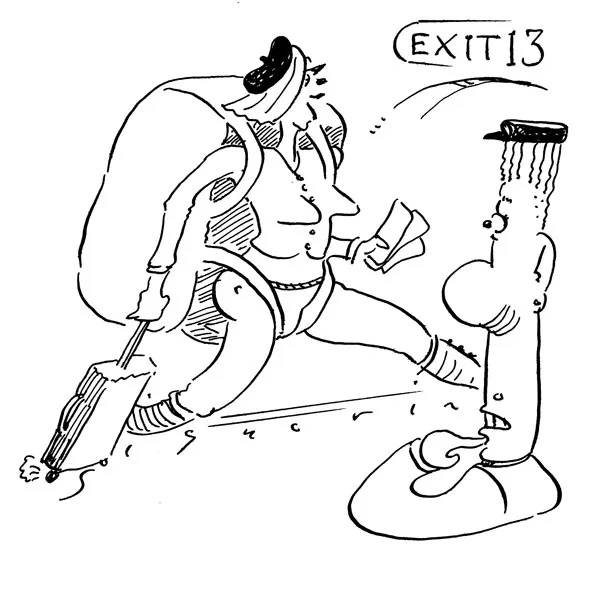
As someone who’s terrified to fly, I’ve always wondered why commercial liners don’t come with emergency parachutes under the seats. In the event of fire or engine failure I’d much rather take my chances on the jump than the crash landing. Few people survive water landings and yet the seat doubles as a flotation device, so I don’t buy the excuse that it’s because people wouldn’t survive with parachutes. —Terra Reneau
I realize this seems like a clever idea, Terra. And I admit the thought of sitting in a doomed aircraft hurtling towards destruction brings out the Walter Mitty in all of us. After all, a 1 percent chance of survival is better than no chance, right? Unfortunately, 1 percent is way too optimistic. To see why, ask yourself a few questions:
What are the odds of an accident happening when a parachute would do you any good? Analyzing 49 years of fatal aviation accidents, Boeing found 12 percent happened on the ground, 20 percent while the aircraft was taking off or on its initial climb, and 36 percent while the aircraft was in final descent or landing. So less than a third of the fatal accidents occurred at a point in the flight when parachute use might have been feasible, and that’s ignoring instant-death scenarios such as TWA 800’s midair explosion or crashing into the side of a mountain.
How do you expect the average passenger to put on a parachute properly? If you’ve done any parachute jumping, you know getting the rig on right is no simple matter, and we all know there are plenty of air travelers who have enough trouble with the seat belt. And what about kids and babies, the elderly, the disabled, the just plain freaked-out? Now add in the chaos of everyone trying to manage this simultaneously in a cramped cabin with little or no instruction under emergency conditions. Ain’t happening, babe.
If by some miracle everybody got properly suited up, how would they get out of the plane? Due to the difference between inside and outside air pressure, a commercial jet’s doors can’t be opened at altitude. If they could, due to the aforesaid pressure differences, everyone would be sucked out and quite likely smashed against the aircraft, pulled into the turbines, or incinerated by the exhaust. True, D.B. Cooper may have eluded these perils in 1971 when he parachuted out of the Boeing 727 he’d hijacked, but he was the only remaining passenger on a depressurized, slow-moving aircraft with a rear-facing exit door, and he had plenty of time to prepare. That’s a far cry from the emergency scenario we’re contemplating.
You object: I still want my .001 percent! Very well, let’s do a little cost-benefit analysis:
What’s that minuscule chance of success going to cost? A typical Boeing 737-800 holds 150 passengers and a crew of maybe six. An Army-grade T-11 model parachute could probably be had for about $600, but remember, we’re dealing with untrained users here—we’re going to need chutes equipped with an automatic activation device and possibly a reserve chute, which cost two grand and up. Factor in the cost of new seats or lockers to stow the parachutes in, maintenance and inspections, and periodic replacement, and it’s safe to say the cost per plane would be upwards of $500,000.
Where would you put the chutes? As air travelers are painfully aware, commercial aircraft can barely accommodate a full load of passengers and their belongings as it is. Each parachute would at minimum take up as much space as a roller bag. Where would they all be kept? Under the seat means no legroom or stowage; overhead means no room for carry-ons.
What about the weight? A T-11 parachute weighs 37 pounds if we skip the reserve chute, but even so we’d be adding 5,800 pounds to the aircraft. We could make this up by eliminating about 26 passengers and their luggage. The good news is this would free up space for everyone else’s chutes. The bad news is ticket prices would likely increase at least 20 percent to cover lost revenue from the missing passengers.
In short, we’re talking exorbitant cost with virtually no payback. By comparison, flotation cushions and life vests for a water landing are the height of practicality. Granted, water landings aren’t common, but they happen—witness the legendary 2009 ditching of US Airways flight 1549 in the Hudson River without fatalities by captain Chesley Sullenberger. Cushions and vests are cheap and easy to use, and the expectation, borne out by experience, is that the plane will be stationary and floating in the water when you exit.
To put things in perspective, your odds of being killed on a given airline flight are something like 1 in 20 million, whereas your odds of dying in a car accident per year are about 1 in 9,200. Not to be heartless, but suck it up.
Send questions to Cecil via StraightDope.com or write him c/o Chicago Reader, 350 N. Orleans, Chicago 60654.